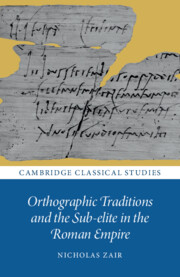Book contents
- Orthographic Traditions and the Sub-elite in the Roman Empire
- Cambridge Classical Studies
- Orthographic Traditions and the Sub-elite in the Roman Empire
- Copyright page
- Dedication
- Contents
- Figures
- Tables
- Foreword
- Note on the Text
- Abbreviations
- Chapter 1 Introduction
- Part I Old-fashioned Spellings
- Part II Apices and i-longa
- Appendix
and in Catullus - Bibliography
- Index
- References
Bibliography
Published online by Cambridge University Press: 25 May 2023
- Orthographic Traditions and the Sub-elite in the Roman Empire
- Cambridge Classical Studies
- Orthographic Traditions and the Sub-elite in the Roman Empire
- Copyright page
- Dedication
- Contents
- Figures
- Tables
- Foreword
- Note on the Text
- Abbreviations
- Chapter 1 Introduction
- Part I Old-fashioned Spellings
- Part II Apices and i-longa
- Appendix and in Catullus
- Bibliography
- Index
- References
Summary
- Type
- Chapter
- Information
- Orthographic Traditions and the Sub-elite in the Roman Empire , pp. 283 - 294Publisher: Cambridge University PressPrint publication year: 2023
- Creative Commons
- This content is Open Access and distributed under the terms of the Creative Commons Attribution licence CC-BY-NC-ND 4.0 https://creativecommons.org/cclicenses/

